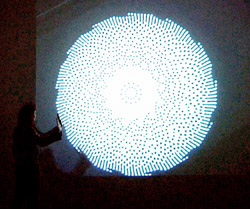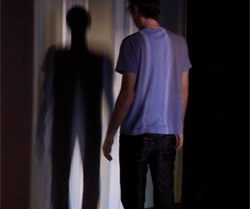|
||||
|
 |
 |
||
March 19-May 7, 2011
Krowswork Gallery is pleased to present Lux ex Machina, featuring tintype photographs by Michelle Kloehn and site specific installations by Chris Fraser and by Ethan Turpin. These three artists are united by their individual investigations into light at its most fundamental and mysterious, using as their tools the physical machines of their respective trades: the photographic camera, the camera obscura, the video camera. Lux ex Machina, or light out of the machine, is a play on “deus ex machina,” a literary conceit in which a situation is resolved through seemingly divine intervention in the form of an unexpected character, plot twist, or equipment. In this exhibition, the conceit indicates a literal revealing of light through these mechanical inquiries at the same time it signals an arrival at a new aesthetic situation through almost inexplicable means. Chris Fraser creates optical installations to shape and shift our expectations of what we term “moving image.” In his installation at Krowswork Fraser turns the twelve-by-twelve-foot project room into a true camera obscura (dark room), where light passes through holes bored in the room’s door and which then bounces throughout the dark box to interact and play out its own course. Yet the effect shifts as people come and go into the room, and this light play is changed and manipulated by passing and entering viewers.* Drawing equally on James Turrell and Thomas Edison, Fraser creates an almost conceptual puzzle, a scientific hypothesis, whose only goal is the stirring of preconceived expectations of what this most fundamental element—light—is and what we really understand about our shared relationship with it in the world. Michelle Kloehn makes tintype photographs, the idea of which conjures an old-fashioned technique of nineteenth-century traveling carnival pictures. Kloehn, however, has literally turned the camera on itself. Her Pieces of Eight series takes as its subject the tintype camera “back,” a eight-sectioned framing device which would have allowed the photographer to grid off her various sitters into individual portraits on a single piece of metal. Instead Kloehn has used it to create shadowy effects among bright white sheets of cut paper and other simple forms, the result of which is a series of unique studies into light and shape. By taking the camera as her subject, she has created a self-reflexive loop whose residue—the photographs themselves—is both conceptually and aesthetically provocative. Ethan Turpin presents in the pew room a live video feedback loop that goes deeper and deeper inside the video itself. Geometries, similar to those found in nature, generate a mutating system of pixel relationships. The resulting patterns look like something one would find through the eye of a microscope looking at a petri dish or like mandala imagery in some ancient Sanskrit book. Yet they come out of light looking at itself through the video camera fixed on the projection screen. What is even more curious about this investigation is that Turpin found that eventually the image disappears altogether—that the patterns dissolve completely and light finds only itself, in full, waveless form. This installation will be accompanied by photo polymer etchings of the video stills themselves.
|
||||
